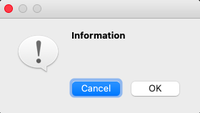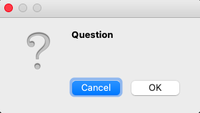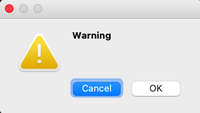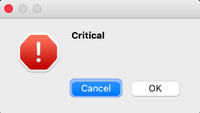PyQt5 - 消息框
在本文中,我们将讨论 PyQT5 模块的 Message Box Widget。它用于显示消息框。 PyQt5是一个用于使用 Qt GUI 框架创建 GUI 的库。 Qt 最初是用 C++ 编写的,但可以在Python。可以使用以下命令安装最新版本的 PyQt5:
pip install PyQt5什么是消息框?
消息框通常用于向用户声明一小段信息。它为用户提供了一个不容错过的弹出框,以避免用户错过重要的错误和信息,并且在某些情况下,用户在不确认消息框的情况下无法继续。

基于应用程序,有四种类型的消息框。以下是创建消息框的语法。对于任何一个盒子,都需要进行实例化。
句法:
msg_box_name = QMessageBox() 现在根据要求创建一个适当的消息框。
消息框的类型
信息留言箱
当需要将相关信息传递给用户时,使用这种类型的消息框。
句法:
msg_box_name.setIcon(QMessageBox.Information)

问题留言箱
此消息框用于从用户那里获得有关要执行的某些活动或操作的答案。
句法:
msg_box_name.setIcon(QMessageBox.Question)

警告信息框
这会触发有关用户将要执行的操作的警告。
句法:
msg_box_name.setIcon(QMessageBox.Warning)

关键消息框
这通常用于获取用户对关键操作的意见。
句法:
msg_box_name.setIcon(QMessageBox.Critical)

使用 PyQt5 创建一个简单的消息框
现在要创建一个生成消息框的程序,首先导入所有必需的模块,然后创建一个带有四个按钮的小部件,单击其中任何一个都会生成一个消息框。
现在,为每个按钮关联一个消息框,该消息框在单击相应按钮时弹出。首先,实例化一个消息框并添加一个所需的图标。现在为将生成的流行音乐设置适当的属性。此外,添加按钮来处理标准机制。
下面给出了完整的实现。
程序:
Python
#import libraries
import sys
from PyQt5.QtWidgets import *
def window():
# create pyqt5 app
app = QApplication(sys.argv)
w = QWidget()
# create buttons
# b1- Information button
b1 = QPushButton(w)
b1.setText("Information")
b1.move(45, 50)
# b2- Warning button
b2 = QPushButton(w)
b2.setText("Warning")
b2.move(150, 50)
# b3- Question button
b3 = QPushButton(w)
b3.setText("Question")
b3.move(50, 150)
# b4- Critical button
b4 = QPushButton(w)
b4.setText("Critical")
b4.move(150, 150)
# declaring command when button clicked
b1.clicked.connect(show_info_messagebox)
b2.clicked.connect(show_warning_messagebox)
b3.clicked.connect(show_question_messagebox)
b4.clicked.connect(show_critical_messagebox)
# setting title of the window
w.setWindowTitle("PyQt MessageBox")
# showing all the widgets
w.show()
# start the app
sys.exit(app.exec_())
def show_info_messagebox():
msg = QMessageBox()
msg.setIcon(QMessageBox.Information)
# setting message for Message Box
msg.setText("Information ")
# setting Message box window title
msg.setWindowTitle("Information MessageBox")
# declaring buttons on Message Box
msg.setStandardButtons(QMessageBox.Ok | QMessageBox.Cancel)
# start the app
retval = msg.exec_()
def show_warning_messagebox():
msg = QMessageBox()
msg.setIcon(QMessageBox.Warning)
# setting message for Message Box
msg.setText("Warning")
# setting Message box window title
msg.setWindowTitle("Warning MessageBox")
# declaring buttons on Message Box
msg.setStandardButtons(QMessageBox.Ok | QMessageBox.Cancel)
# start the app
retval = msg.exec_()
def show_question_messagebox():
msg = QMessageBox()
msg.setIcon(QMessageBox.Question)
# setting message for Message Box
msg.setText("Question")
# setting Message box window title
msg.setWindowTitle("Question MessageBox")
# declaring buttons on Message Box
msg.setStandardButtons(QMessageBox.Ok | QMessageBox.Cancel)
# start the app
retval = msg.exec_()
def show_critical_messagebox():
msg = QMessageBox()
msg.setIcon(QMessageBox.Critical)
# setting message for Message Box
msg.setText("Critical")
# setting Message box window title
msg.setWindowTitle("Critical MessageBox")
# declaring buttons on Message Box
msg.setStandardButtons(QMessageBox.Ok | QMessageBox.Cancel)
# start the app
retval = msg.exec_()
if __name__ == '__main__':
window()输出
